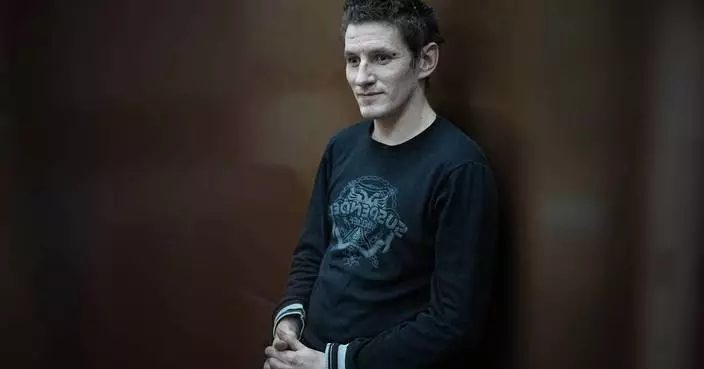Eddie Palmieri, "Mi Luz Mayor" (Ropeadope)
It might be the winter season for the U.S., but Eddie Palmieri brings the sunshine and warmth with his latest album, "Mi Luz Mayor."
The Spanish Harlem, New Yorker is a living legend and cultural treasure — chances are you've heard his melodies or tunes influenced by him during your last vacation in the Caribbean, or when you walked through Washington Heights on your way to the Cloisters.
"Mi Luz Mayor," which loosely translates into "My Eternal Light," is filled with bright, melodic tunes that are almost guaranteed to make you get up and salsa — or at least try.
The eight-time Grammy winner recruited dozens of renowned musicians for the album, including frequent collaborators Jimmy Bosch, Luques Curtis, Brian Lynch and Little Johnny Rivero. The album is comprised of eight salsa arrangements, along with three originals — "Mi Congo" featuring famed guitarist Carlos Santana, the title track and "Yo Soy Mulato," an ode to his grandmother of African descent.
Songs like "Chica Ni Lambo," ''Abarriba Cumbiaremos" and "Quimbombo" — the latter two featuring a superb Herman Olivera — grab you and transport you into a tiny Puerto Rican cafe, where the locals effortlessly glide, spin and twirl into the night. There's also the beautiful "Que Falta Tu Me Haces," a slower ballad sang so beautifully by the esteemed Gilberto Santa Rosa you'll be encouraged to play it for the one you adore, even if you don't completely understand the Spanish lyrics.
"Mi Luz Mayor," Palmieri's second full-length release this year, was created in love: The pianist, bandleader and composer, who turns 82 on Saturday, said it is reminiscent of the "music that my late wife, Iraida, and I enjoyed in our youth" (Palmieri lost his wife to cancer in 2014).
Though it is dedicated to his wife, this isn't an album of heartbreak or mourning, but instead a celebration of the happy memories he shared with the love of his life.
"Mi Luz Mayor" is sure to make you smile, tap your foot or even get up and dance, even if Latin jazz isn't your go-to genre. Salsa lessons, however, are not included.
VENICE. Italy (AP) — Jeffrey Gibson’s takeover of the U.S. pavilion for this year’s Venice Biennale contemporary art show is a celebration of color, pattern and craft, which is immediately evident on approaching the bright red facade decorated by a colorful clash of geometry and a foreground dominated by a riot of gigantic red podiums.
Gibson, a Mississippi Choctaw with Cherokee descent, is the first Native American to represent the United States solo at the Venice Biennale, the world’s oldest contemporary art show. For context, the last time Native American artists were included was in 1932.
Gibson, 52, accepts the weight of the honor, but he prefers to focus on how his participation can forge greater inclusion going forward.
“The first is not the most important story," Gibson told The Associated Press this week before the pavilion’s inauguration on Thursday. “The first is hopefully the beginning of many, many, many more stories to come."
The commission, his first major show in Europe, comes at a pivotal moment for Gibson. His 2023 book “An Indigenous Present" features more than 60 Indigenous artists, and he has two major new projects, a facade commission for the Metropolitan Museum of Art in New York and an exhibition at the Massachusetts Museum of Contemporary Art.
Gibson’s eye-catching exhibition titled “the space in which to place me," features text in beadwork sculptures and paintings taken from U.S. founding documents, music, sermons and proverbs to remind the viewer of the broken promises of equity through U.S. history. The vibrant use of color projects optimism. In that way, Gibson’s art is a call to action.
“What I find so beautiful about Jeffrey’s work is its ability to function as a prism, to take the traumas of the past and the questions about identity and politics and refract them in such a way that things that realities that have become flattened … can become these beautiful kaleidoscopes, which are joyous and celebratory and critical all at the same time," said Abigail Winograd, one of the exhibition’s curators.
“When I see people walk through the pavilion and kind of gasp when they walk from room to room, that’s exactly what we wanted," Winograd said.
Entering the pavilion, the beaded bodices of sculptures in human form are emblazoned with dates of U.S. legislation that promised equity, the beading cascading into colorful fringe. A painting quotes George Washington writing, “Liberty, when it begins to take root, is a plant of rapid growth," in geometric letters that meld into a colorful patterned background.
By identifying specific moments in U.S. history, Gibson said that he wants to underline that “people who are fighting for equity and justice today, we’re not the first.
“This has been a line in the history of American culture. But I’m hoping that people will think about why … some of these things … have either been revoked or have not come into fruition,” he said.
Craft is at the center of Gibson’s art, both in defiance of past denigration of craft and as a way to confront “the traumatic histories of Native American people,” he said.
“There is something very healing about the cycle of making," Gibson explained.
The pavilion’s intricate beaded sculptures owe a debt to Native American makers of the past without imitating them, employing couture techniques to create something completely new. In the way of his forbears, Gibson uses beads sourced from all over the world, including vintage beads from Japan and China, and glass beads from the Venetian island of Murano.
Paper works incorporate vintage beadwork purchased from websites, estate and garage sales in mixed media displays that honor the generations of Native American makers that preceded him.
Gibson's themes fit well into the message of inclusion of the main Biennale exhibition, titled “Stranieri Ovunque -- Strangers Everywhere,” which runs in tandem with around 90 national pavilions from April 20-Nov. 24.
His personal history has placed him firmly in what he calls the “diasporic history of Indigenous people.” His father's job took his family abroad when he was a child to Germany and then South Korea, and he later studied in Chicago and London. His partner is Norwegian artist Rune Olsen.
Through all of this, Gibson has picked up traditions and practices that go beyond his Indigenous background.
“I’ve looked at op art, pattern and decoration. I've looked at psychedelia, I have taken part in rave culture and queer culture and drag and the whole spectrum," Gibson said.
"And so for me, I would not be telling you the whole truth if I only chose to spoke about indigeneity. But my body is an Indigenous body — it’s all funneled through this body,'' he said. ”And so my hope is that by telling my experience, that everyone else can project their own kind of intersected, layered experience into the world.”
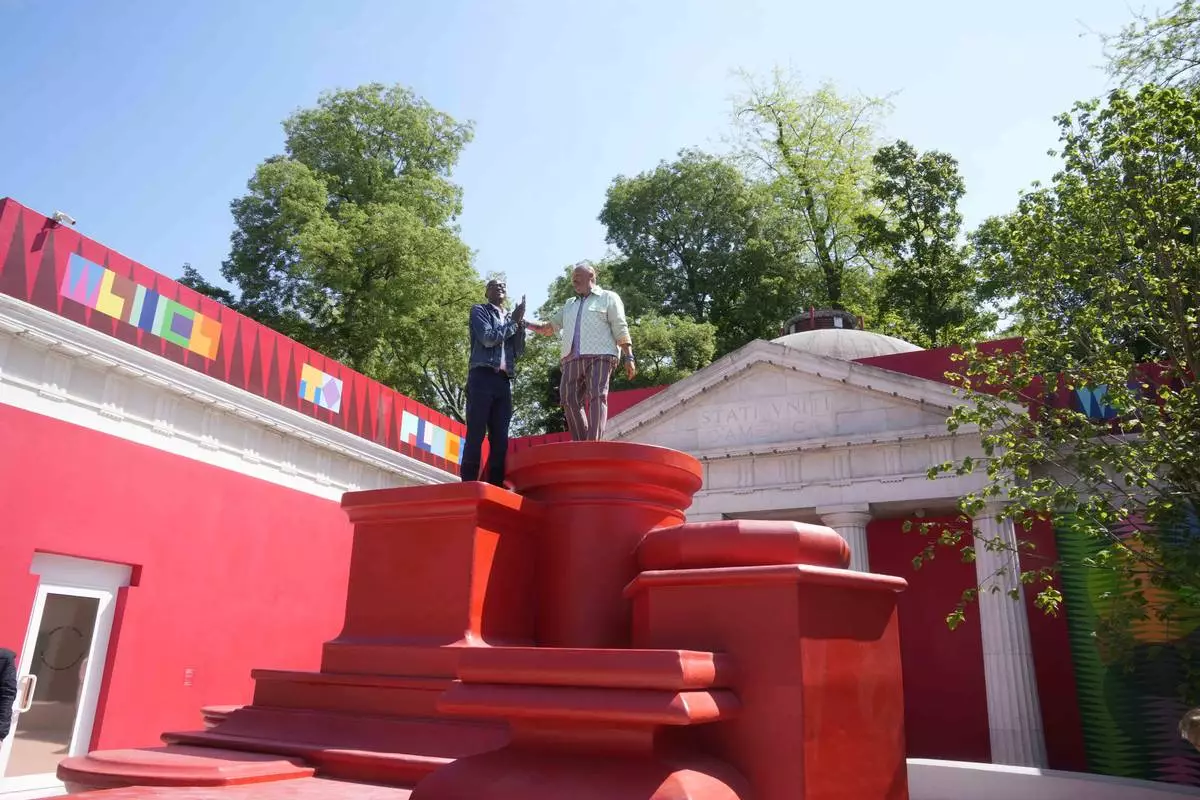
Artist Jeffrey Gibson, right, poses with artist Mark Bradford at the U.S. pavilion during the media open day at the 60th Biennale of Arts in Venice, Italy, Tuesday, April 16, 2024. A Mississippi Choctaw of Cherokee descent, Gibson is the first Native American to represent the United States solo at the Venice Biennale, the world’s oldest contemporary art show. Gibson mixes Western modernism and Native American craft in his vibrantly hued paintings and sculptures. (AP Photo/Luca Bruno)
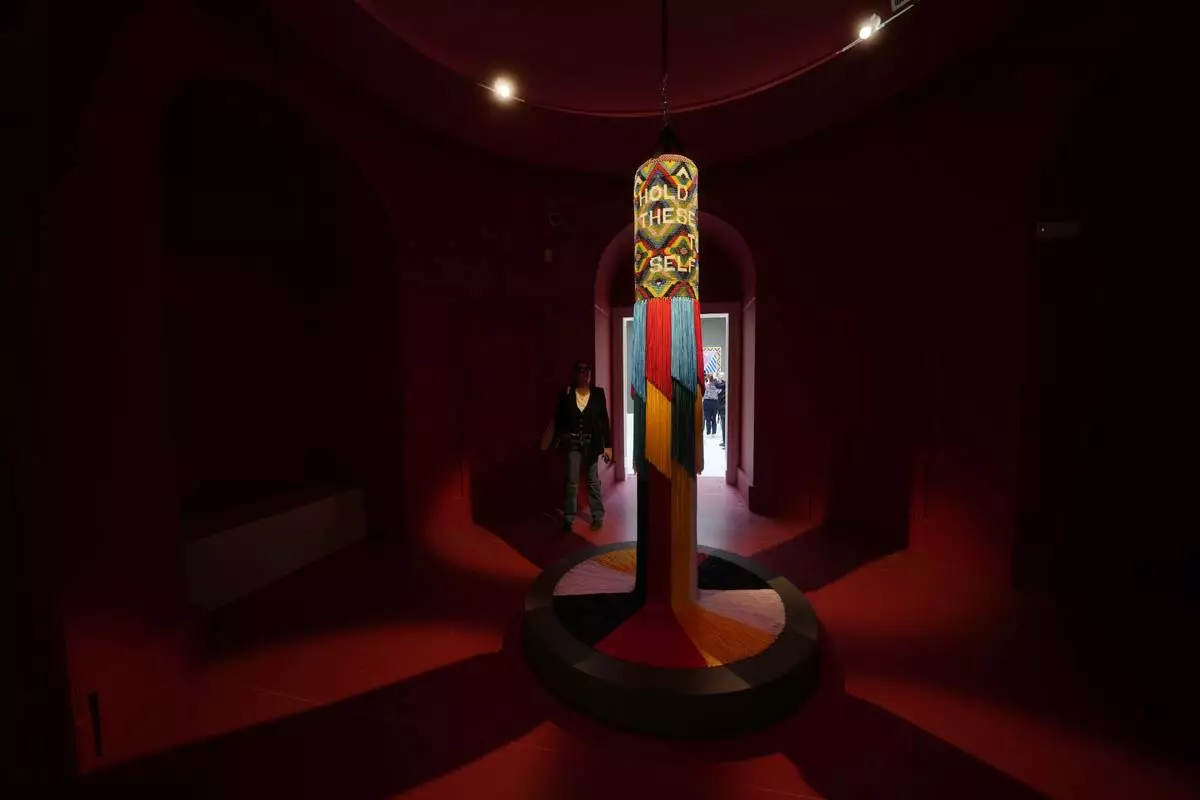
Visitors look at sculptures on display inside the US pavilion by artist Jeffrey Gibson during the 60th Biennale of Arts in Venice, Italy, Tuesday, April 16, 2024. A Mississippi Choctaw of Cherokee descent, Gibson is the first Native American to represent the United States solo at the Venice Biennale, the world’s oldest contemporary art show. Gibson mixes Western modernism and Native American craft in his vibrantly hued paintings and sculptures. (AP Photo/Luca Bruno)
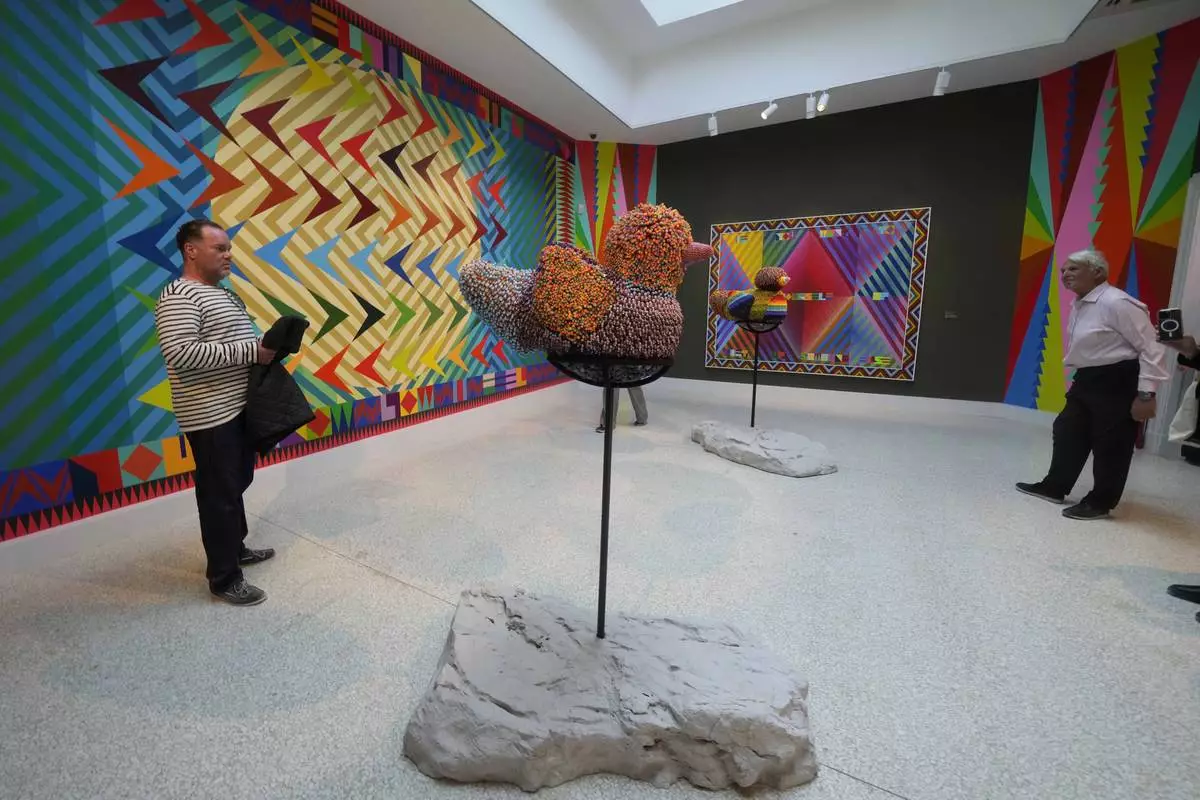
Visitors look at sculptures on display inside the US pavilion by artist Jeffrey Gibson during the 60th Biennale of Arts in Venice, Italy, Tuesday, April 16, 2024. A Mississippi Choctaw of Cherokee descent, Gibson is the first Native American to represent the United States solo at the Venice Biennale, the world’s oldest contemporary art show. Gibson mixes Western modernism and Native American craft in his vibrantly hued paintings and sculptures. (AP Photo/Luca Bruno)

Visitors look at sculptures on display inside the US pavilion by artist Jeffrey Gibson during the 60th Biennale of Arts in Venice, Italy, Tuesday, April 16, 2024. A Mississippi Choctaw of Cherokee descent, Gibson is the first Native American to represent the United States solo at the Venice Biennale, the world’s oldest contemporary art show. Gibson mixes Western modernism and Native American craft in his vibrantly hued paintings and sculptures. (AP Photo/Luca Bruno)

Visitors look at sculptures on display inside the US pavilion by artist Jeffrey Gibson during the 60th Biennale of Arts in Venice, Italy, Tuesday, April 16, 2024. A Mississippi Choctaw of Cherokee descent, Gibson is the first Native American to represent the United States solo at the Venice Biennale, the world’s oldest contemporary art show. Gibson mixes Western modernism and Native American craft in his vibrantly hued paintings and sculptures. (AP Photo/Luca Bruno)
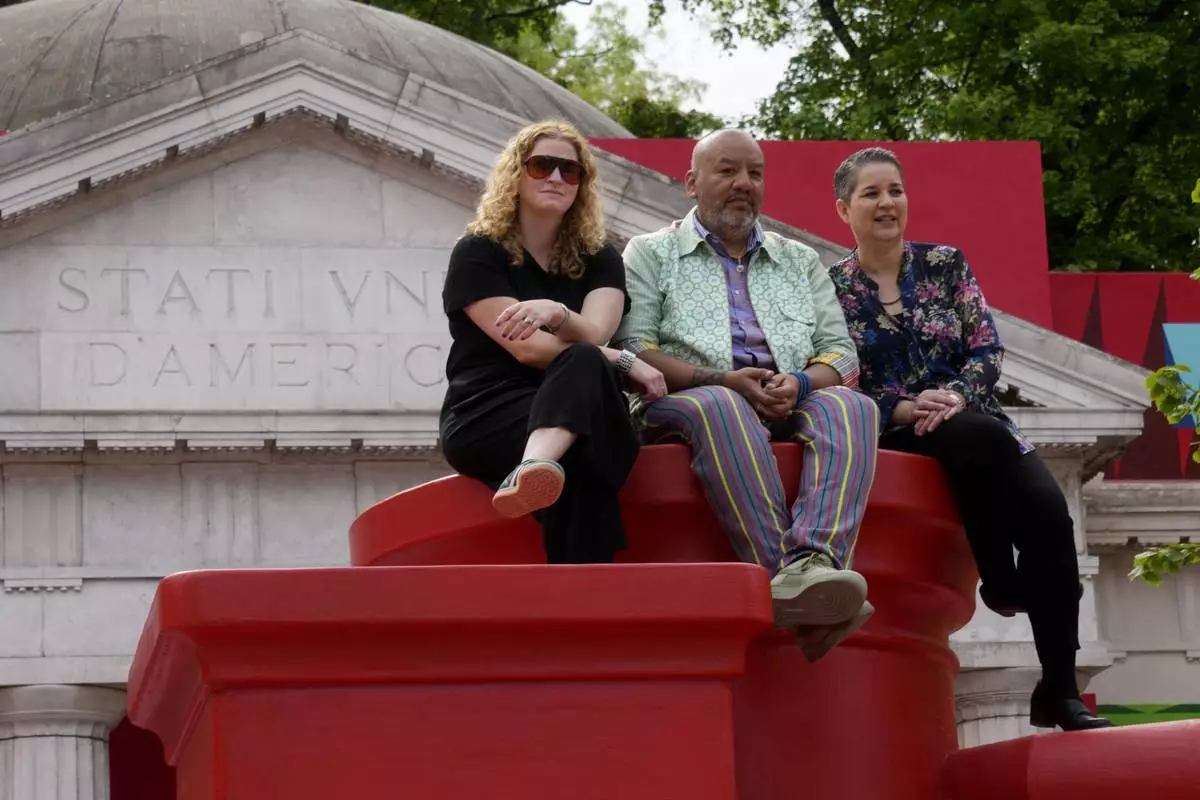
From left, Curator Abigail Winograd, artist Jeffrey Gibson, and Curator Kathleen Ash-Milby pose at the US pavilion during the media open day at the 60th Biennale of Arts in Venice, Italy, Tuesday, April 16, 2024. A Mississippi Choctaw of Cherokee descent, Gibson is the first Native American to represent the United States solo at the Venice Biennale, the world’s oldest contemporary art show. Gibson mixes Western modernism and Native American craft in his vibrantly hued paintings and sculptures. (AP Photo/Luca Bruno)
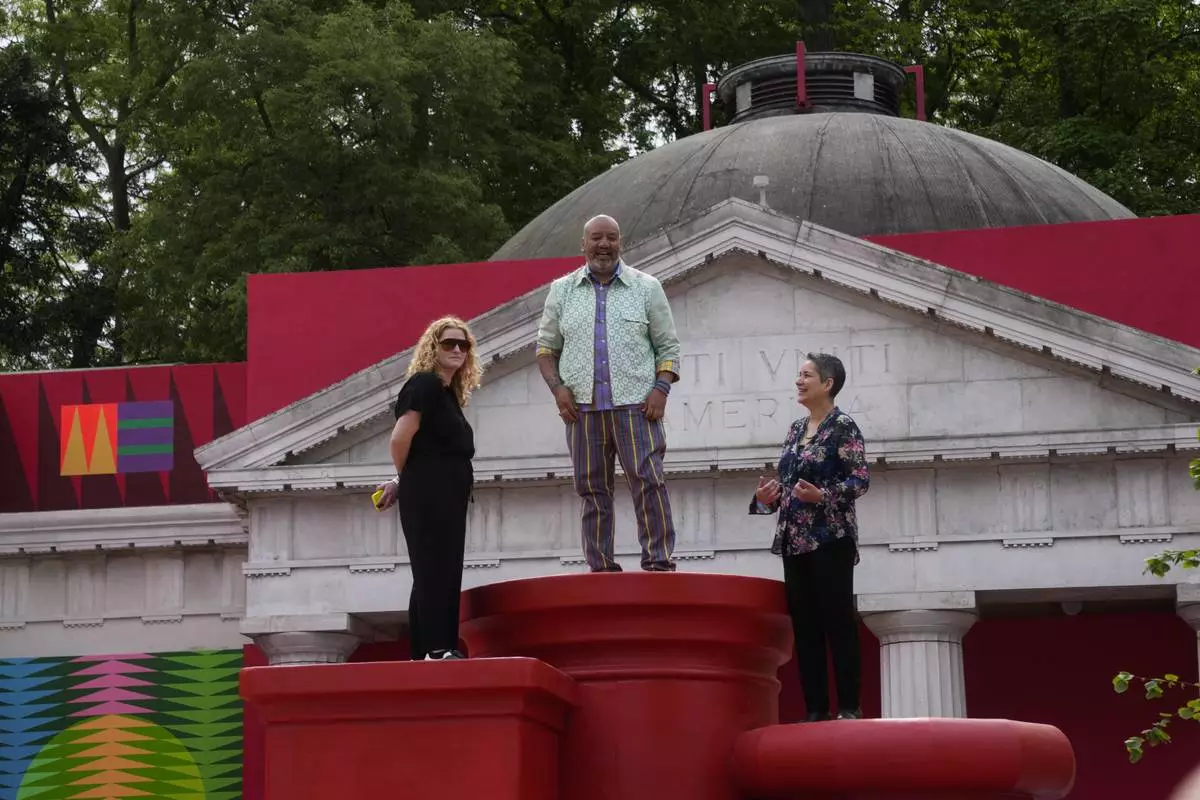
From left, Curator Abigail Winograd, artist Jeffrey Gibson, and Curator Kathleen Ash-Milby pose at the US pavilion during the media open day at the 60th Biennale of Arts in Venice, Italy, Tuesday, April 16, 2024. A Mississippi Choctaw of Cherokee descent, Gibson is the first Native American to represent the United States solo at the Venice Biennale, the world’s oldest contemporary art show. Gibson mixes Western modernism and Native American craft in his vibrantly hued paintings and sculptures. (AP Photo/Luca Bruno)
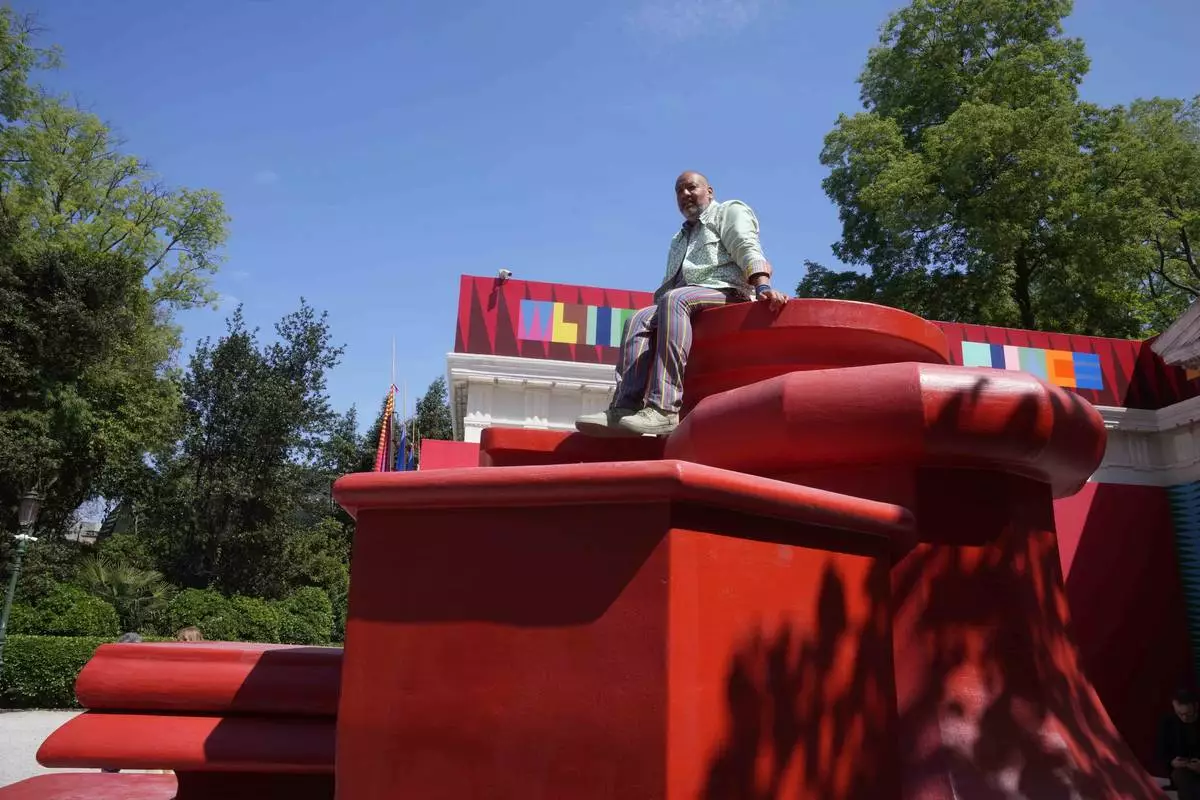
Artist Jeffrey Gibson poses at the US pavilion during a media open day at the 60th Biennale of Arts in Venice, Italy, Tuesday, April 16, 2024. A Mississippi Choctaw of Cherokee descent, Gibson is the first Native American to represent the United States solo at the Venice Biennale, the world’s oldest contemporary art show. Gibson mixes Western modernism and Native American craft in his vibrantly hued paintings and sculptures. (AP Photo/Luca Bruno)
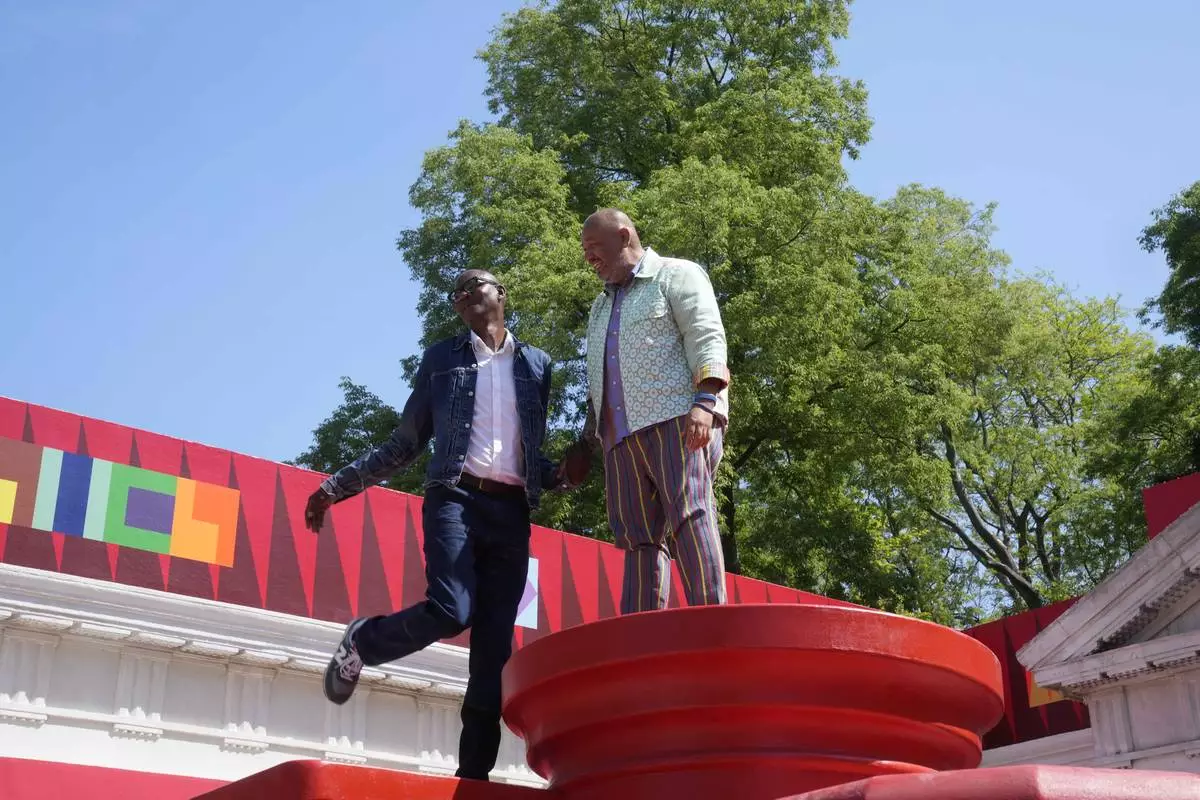
Artist Jeffrey Gibson, right, poses with artist Mark Bradford at the U.S. pavilion during the media open day at the 60th Biennale of Arts in Venice, Italy, Tuesday, April 16, 2024. A Mississippi Choctaw of Cherokee descent, Gibson is the first Native American to represent the United States solo at the Venice Biennale, the world’s oldest contemporary art show. Gibson mixes Western modernism and Native American craft in his vibrantly hued paintings and sculptures. (AP Photo/Luca Bruno)
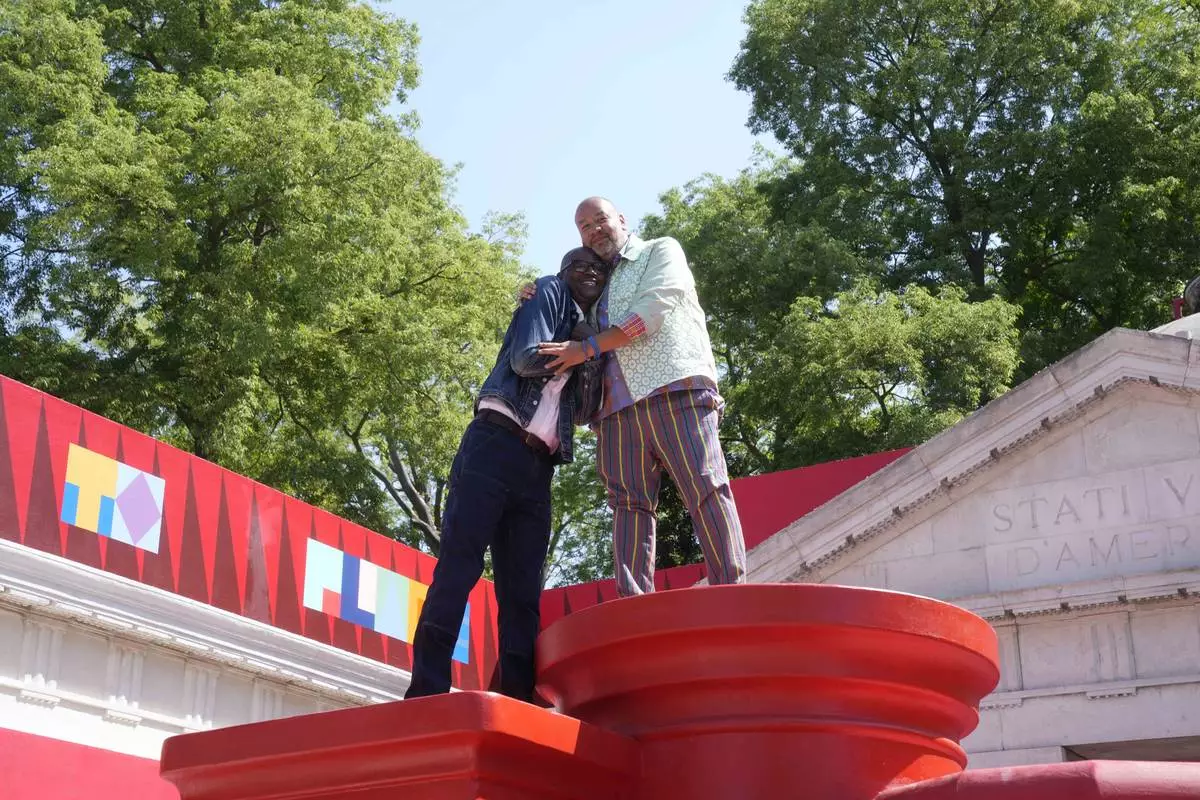
Artist Jeffrey Gibson, right, hugs artist Mark Bradford at the U.S. pavilion during media open day of the 60th Biennale of Arts exhibition in Venice, Italy, Tuesday, April 16, 2024. A Mississippi Choctaw of Cherokee descent, Gibson is the first Native American to represent the United States solo at the Venice Biennale, the world’s oldest contemporary art show. Gibson mixes Western modernism and Native American craft in his vibrantly hued paintings and sculptures. (AP Photo/Luca Bruno)
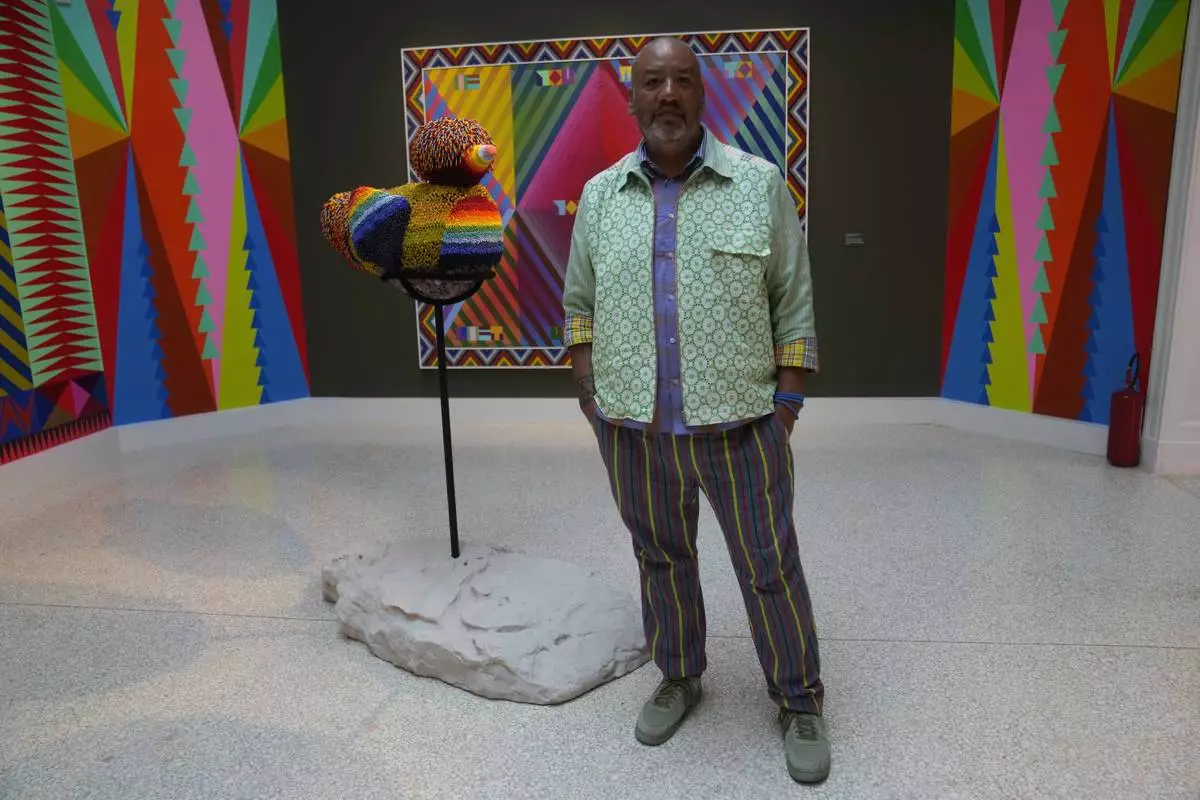
Artist Jeffrey Gibson poses inside the US pavilion during the media open day at the 60th Biennale of Arts in Venice, Italy, Tuesday, April 16, 2024. A Mississippi Choctaw of Cherokee descent, Gibson is the first Native American to represent the United States solo at the Venice Biennale, the world’s oldest contemporary art show. Gibson mixes Western modernism and Native American craft in his vibrantly hued paintings and sculptures. (AP Photo/Luca Bruno)



















